 Washington D.C. Chinatown Washington D.C. Chinatown
USA
 Once in the long shadow of the White House on Pennsylvania Avenue, today’s Chinatown in Washington, D.C., is now in the heart of the nation’s business district, near the famous K Street, home of Washington’s power brokers, art galleries, the Smithsonian Museums, the Verizon sports and entertainment Centre, on H and I Streets between 5 and 8 Streets, Northwest. Once in the long shadow of the White House on Pennsylvania Avenue, today’s Chinatown in Washington, D.C., is now in the heart of the nation’s business district, near the famous K Street, home of Washington’s power brokers, art galleries, the Smithsonian Museums, the Verizon sports and entertainment Centre, on H and I Streets between 5 and 8 Streets, Northwest.
Washington’s Chinatown is America’s third largest Chinatown servicing an Asian population of 333 000 [2000 Census], among which the Chinese hold a prominent place. Unlike San Francisco and New York Chinatowns, the Chinese live not in crowded spaces in Chinatown, but outside of Washington, mostly in suburban Fairfax, Virginia and Montgomery County in Maryland.
Washington’s Chinatown in its current location is hardly 80 years old. It has its own metro stop, Gallery Place-Chinatown, and along its main thoroughfare are restaurants, general stores, a video shop, and houses a number of Chinese-American cultural and religious charities.
The 1968 riots following on the heel of Martin Luther King’s assassination brought a general decline to Chinatown, and hastened the move of Chinese to Maryland and Virginia. It took almost 40 years for the area to recover, and an investment of us$200m to transform Chinatown into a bustling area of up market restaurants and night clubs. Infusions of capital also brought non Chinese owned stores into Chinatown, such as, among others, Starbucks, Hooters, CVS [a nationwide chemist chain], and especially the Verizon Centre which challenges its distinctive identity. To preserve the ‘Chinese’ character of Chinatown, local ordnances require that businesses there hang signs in Chinese and English to preserve its local character. The Chinese ideogrammes add local colour and pizzaz to what was once a “war zone”. Saying this, gentrification is slowly changing Chinatown, although its 20 restaurants are owned by Chinese Americans. They offer a various regional cuisines, thereby maintaining variety for the palate that craves Chinese cooking.
In Washington, Chinatown is a venerable and valuable institution. Its restaurants and nightclubs are popular because it allows ordinary people and the famous, not only to eat in the same establishments or enjoy night life in clubs. There visitors and ordinary Washingtonians mix with celebrity politicians, the diplomatic and the press corps, the lobbyists, and the capitol’s nationally recognized talking heads.
Washington Chinatown’s distinctive attraction is its traditional gate, Friendship Archway on H and 7 Streets, Northwest. Dedicated in 1986, it was designed by a local son, Alfred Liu, at a cost of US$1m. Sixty feet high, it has 7 roofs, 7000 tiles in red, green, and yellow, and 262 lavishly painted dragons in the Ming and Qing styles.
Washington’s Chinatown bustles with activity day and night, but it is at Chinese New Year that it draws crowds. Its New Year parade, organized by the Chinatown Chamber of Commerce, is a crowd pleaser with the traditional Lion Dance, the cymbals and drums, an assortment of traditional Chinese instruments, alongside of marching bands, majorettes, and clan participation. And then there’s the lighting of 5 storey firecrackers and petards which never fail to delight the assembled onlookers.
The rapid growth of tourism from the Chinese mainland and the explosion of Chinatowns in Chinatowns on the Atlantic seaboard, have given rise to vigorous growth in ground transportation which is Chinese American owned. They swell tourism to Washington and its Chinatown, and do drop off and pick up passengers there. So, not unlike other Chinatowns, Washington’s has an infusion of the new wave of emigration and the longer settled American Chinese, thereby enhancing ties and bonds to a 5000 year old culture which in ways small and not so small enhance the character of America’s melting pot.
Article contributed by Dr. Jak Cambria
Related article:
|
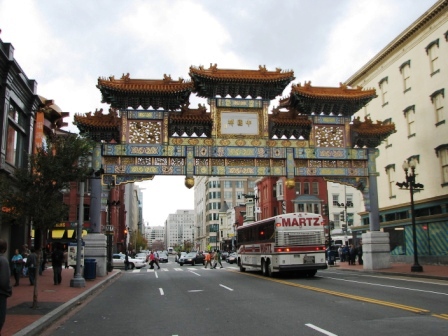
Archway, paifang to Wahsington DC Chinatown
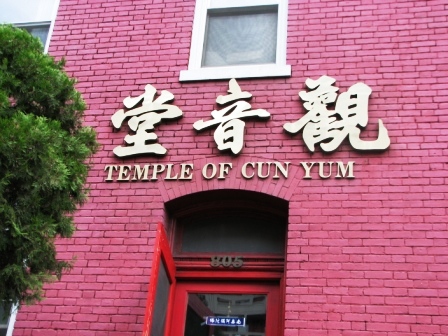
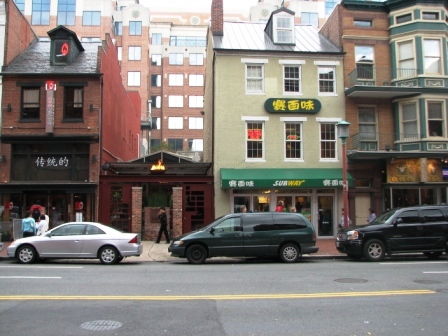
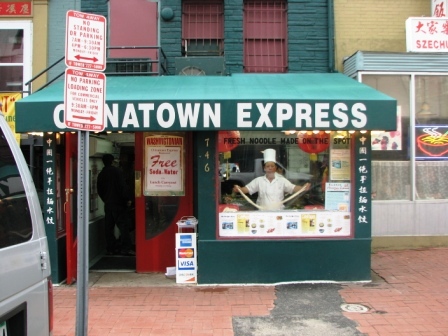
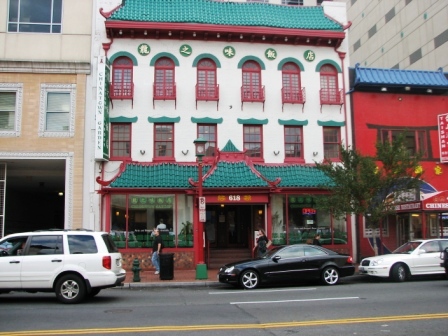
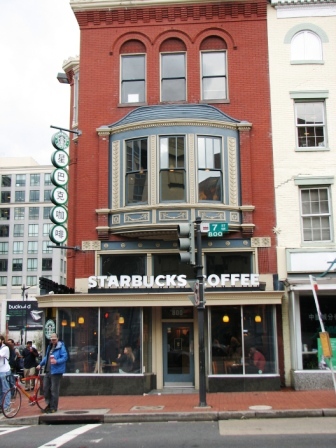
Starbucks with Chinese brand name
|

 Washington D.C. Chinatown
Washington D.C. Chinatown Once in the long shadow of the White House on Pennsylvania Avenue, today’s Chinatown in Washington, D.C., is now in the heart of the nation’s business district, near the famous K Street, home of Washington’s power brokers, art galleries, the Smithsonian Museums, the Verizon sports and entertainment Centre, on H and I Streets between 5 and 8 Streets, Northwest.
Once in the long shadow of the White House on Pennsylvania Avenue, today’s Chinatown in Washington, D.C., is now in the heart of the nation’s business district, near the famous K Street, home of Washington’s power brokers, art galleries, the Smithsonian Museums, the Verizon sports and entertainment Centre, on H and I Streets between 5 and 8 Streets, Northwest. 




